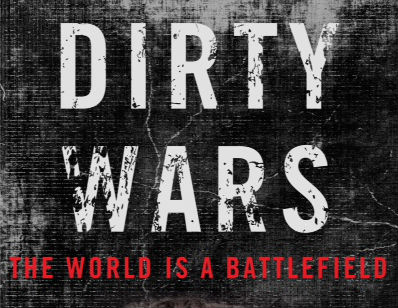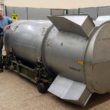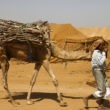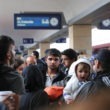(Jeremy Scahill’s new book Dirty Wars: The World Is a Battlefield, which reports on America’s covert operations in Africa, Asia and the Middle East, was made into a documentary that competed at the Sundance Film Festival in January.)
Editor’s note: In today’s post from TomDispatch.com, Tom Engelhardt once against connects the dots. In focusing on Jeremy Scahill new book, he asks: Does the manhunt for suspected terrorist Dzhokhar Tsarnaev mark a turning point in which America’s imperial wars have come home? Yes, if U.S. Senator Lindsey Graham is any indicaiton. After Tsarnaev was captured on April 19, Graham called on President Barack Obama to designate him an “enemy combatant.” The reason? “The homeland is the battlefield.”
Chalmers Johnson’s Blowback: The Costs and Consequences of American Empire was published in March 2000 — and just about no one noticed. Until then, blowback had been an obscure term of CIA tradecraft, which Johnson defined as “the unintended consequences of policies that were kept secret from the American people.” In his prologue, the former consultant to the CIA labeled his Cold War self a “spear-carrier for empire.”
After the Soviet Union disappeared in 1991, he was surprised to discover that the essential global structure of the American superpower, with its vast panoply of military bases, remained obdurately in place as if nothing had happened. Almost a decade later, when the Evil Empire was barely a memory, Johnson surveyed the planet and found “an informal American empire” of immense reach and power. He also became convinced that Washington was laying the groundwork “all around the world… for future forms of blowback.”
Johnson noted “portents of a twenty-first century crisis” in the form of, among other things, “terrorist attacks on American installations and embassies.” In the first chapter of Blowback, he focused in particular on a “former protégé of the United States” by the name of Osama bin Laden and on the Afghan War against the Soviets from which he and an organization called al-Qaeda had emerged. It had been a war that Washington backed to the hilt. The CIA funded and armed the most extreme Islamic fundamentalists, paving the way for a Taliban takeover Afghanistan.
The purpose of that war had been to give the Soviet Union a bloody nose. All of this laid the foundation for… well, in 1999 when Johnson was writing, no one knew what. But he, at least, had an inkling, which on September 12, 2001, made his book look prophetic. He emphasized one other phenomenon: Americans, he believed, had “freed ourselves of… any genuine consciousness of how we might look to others on this globe.”
With Blowback, he aimed to paint a portrait of how that informal empire looked to others, and explain why animosity and blowback were building globally. After September 11, his book became a bestseller, while “blowback” and that phrase “unintended consequences” made their way into our everyday language.
| Scahill fills us in on American military death squads in Iraq, secret renditions in Somalia, the assassination of American citizens in Yemen, and the complex world of CIA-Blackwater operations in Pakistan. |
Johnson was, you might say, our first blowback scholar. Now, more than a decade later, we have a book from our first blowback reporter. His name is Jeremy Scahill. In 2007, he, too, produced a surprise bestseller, Blackwater: The Rise of the World’s Most Powerful Mercenary Army. It caught the mood of a moment in which the Bush administration, in service to its foreign wars, was working manically to “privatize” national security and the U.S. military by hiring rent-a-spies, rent-a-guns, and rent-a-corporations for its proliferating wars.
In the ensuing years, it was as if Scahill had taken Johnson’s observation to heart — that we Americans can’t see our world as it is. And little wonder, since Washington has transformed an increasingly militarized CIA, a hush-hush crew called the Joint Special Operations Command (JSOC), and a shiny new “perfect weapon” and high-tech fantasy object, the drone, into the president’s own privatized military.
In these years, war and the path to it were becoming the private business and property of the White House and the national security state — and no one else. Little of this, of course, was a secret to those on the receiving end. It was only Americans who were not supposed to know much about what was being done in their name. As a result, there was a secret history of twenty-first-century American war crying out to be written. Now, we have it in the form of Scahill’s latest book, Dirty Wars: The World Is a Battlefield.
Scahill has tracked, in particular, the rise of the JSOC. In Iraq, it grew into a kind of Murder Inc., “an executive assassination wing,” as Seymour Hersh once put it, operating out of Vice President Dick Cheney’s office. It next turned its hunter/killer methods on Afghanistan and then on the planet, as the special operations forces themselves grew into an expansive secret military cocooned inside the U.S. military. In those years, Scahill started following the footsteps of special ops types into the field, while mainlining into sources in their community as well as other parts of the American military and intelligence world.
In his new book, he dramatically retraces the bureaucratic intel wars in Washington as the Pentagon, the CIA, and the rest of the U.S. Intelligence Community muscled up, and secret presidential orders gave the JSOC, in particular, unprecedented authority to turn the globe into a free-fire zone. Finally, as a reporter, he traveled to a series of danger spots — Somalia, Yemen, Pakistan — that Americans could care less about, where the U.S. military and the CIA (in conjunction with private security contractors) were developing new ways of waging secret wars.
Scahill fills us in on those American military death squads in Iraq, nightmarish special ops night raids in Afghanistan (that target all the wrong people), secret renditions of terror suspects to a CIA-funded jail in Somalia (after President Obama had forsworn “rendition”), the dispatching of drones and cruise missiles in disastrous strikes on civilians in Yemen, the hunting down and assassination of American citizens (aka terror suspects, although 16-year-old Abdulrahman Awlaki certainly wasn’t one) also in Yemen on the orders of the president, the complex world of JSOC-CIA-Blackwater operations in Pakistan — and so much more, including an indication that JSOC has even launched secret ground operations of some sort in Uzbekistan. (Who knew?)
Dirty Wars is also a history of the future; that is, a history of potential blowback-to-come, a message in a bottle sent to us from the hidden front lines of America’s global battlefields — and therein lies a tale of tales.
Preparing the battlefield
A couple of years back, TomDispatch correspondent Ann Jones told me something I’ve never forgotten. Having spent time with U.S. troops in Afghanistan, she described their patrols in the countryside this way: yes, there were dangers, mainly IEDs (roadside bombs) and the odd potshot taken at them, but on the whole the areas they patrolled every day were eerily “empty.” In some sense, it almost seemed as if no one was there, as if they were fighting a ghost war on — her term — an empty battlefield.
| When the neocons in the Bush administration declared a Global War on Terror, they weren’t kidding. |
As it happens, her observation has a planetary analogue that lies at the heart of Scahill’s remarkable book. As you may remember, in the wake of the 9/11 attacks, it took no time at all for Bush administration officials to think big. Notoriously, Secretary of Defense Donald Rumsfeld began urging aides to build a case against Iraqi dictator Saddam Hussein only five hours after American Airlines Flight 77 crashed into the Pentagon. Within weeks administration figures were already talking with confidence about the need to “drain the swamp” of terrorists and enemies on a global scale. They were reportedly planning to target 60 to 80 countries, almost a third to close to one-half of the nations on this planet. In other words, when they quickly declared a Global War on Terror, they weren’t kidding. They meant it quite literally and, as Scahill reports, they promptly went to work building up the kinds of forces — secret and at their command alone — that could fight anywhere on the sly.
As these forces were dispatched globally to collect intelligence, train foreign forces (also often “special” and secret), and especially hunt and kill terrorists, a new tradecraft term came into play, a phrase as crucial to Scahill’s book as “blowback” was to Johnson’s. They were, it was claimed, going out to “prepare the battlefield” (or alternately, “the battlespace” or “the environment”). That process of preparation couldn’t have been more breathtakingly hubristic. Secretary of Defense Rumsfeld summed up the situation this way: “Today, the entire world is the ‘battlespace.’”
Here’s the strange thing, though: when those secret forces went out to do their dirty work, that global battlefield was, using Jones’s term, remarkably, eerily empty. There was hardly anyone there. Perhaps hundreds or at most a few thousand jihadis scattered mainly in the backlands of the planet. If “preparing the battlefield” turned out to be the crucial term of the era, it wasn’t exactly a descriptively accurate one. More on the mark might have been: “creating the battlefield” or “filling the empty battlefield.”
The pattern that Scahill traces brilliantly might have boiled down to a version of the tag line for the movie Field of Dreams: if you prepare it, they will come. The result was not so much a war on, as a war of, and for, terror. Washington would, at one and the same time, produce a killing machine and a terror-generating machine. Dirty Wars catches the way its top officials became convinced that the planet’s last superpower, with “the finest fighting force the world has ever known,” could simply kill its way to victory globally.
 As Scahill also shows, they were often remarkably successful at eliminating the figures on their “kill list” of targeted enemies from Osama bin Laden on down: Bin Laden himself in Pakistan, Abu Musab al-Zarqawi in Iraq, Aden Hashi Ayro in Somalia, Anwar al-Awlaki in Yemen, as well as various “lieutenants” of top al-Qaeda figures and allied groups. And yet, as those on the kill lists died, thanks to the CIA’s drones and JSOC’s raiders, so did others. Often enough, they were innocent civilians — and in quantity. People who shouldn’t have ever had their doors kicked in, their sons arrested or their pregnant wives shot down, and who bitterly resented what they experienced. And so before Washington knew it, the kill list was growing larger, not smaller, and its wars were becoming more, not less, intense and spreading to other lands. The battlefield, copiously prepared, was filling with enemies.
As Scahill also shows, they were often remarkably successful at eliminating the figures on their “kill list” of targeted enemies from Osama bin Laden on down: Bin Laden himself in Pakistan, Abu Musab al-Zarqawi in Iraq, Aden Hashi Ayro in Somalia, Anwar al-Awlaki in Yemen, as well as various “lieutenants” of top al-Qaeda figures and allied groups. And yet, as those on the kill lists died, thanks to the CIA’s drones and JSOC’s raiders, so did others. Often enough, they were innocent civilians — and in quantity. People who shouldn’t have ever had their doors kicked in, their sons arrested or their pregnant wives shot down, and who bitterly resented what they experienced. And so before Washington knew it, the kill list was growing larger, not smaller, and its wars were becoming more, not less, intense and spreading to other lands. The battlefield, copiously prepared, was filling with enemies.
A perpetual motion machine for the destabilization of the planet
As Washington launched its post-9/11 adventures, the neoconservative allies of the Bush administration, believing the wind in their sails, eyed the vast area from North Africa to the Central Asian border of China (aka “the Greater Middle East”) that they liked to call the “arc of instability.” The job of the U.S., they imagined, was to bring stability to that “arc” by using America’s overwhelming military power to create a Pax Americana in the region.
In the wake of the American withdrawal from Iraq and in light of the ongoing disastrous war in Afghanistan, if you look at the Greater Middle East today — from Pakistan to Syria, Afghanistan to Mali — you’ll know what instability is really all about. Twelve years later, much of the region has been destabilized to one degree or another, which might pass as the definition for Washington of short-term success and long-term failure.
In reality, they should have known better from the start. After all, behind the global war launched by the Bush administration and carried on by Obama was a twenty-first-century replay of a brutal flop of a strategy in Washington’s failed war in Vietnam. The phrase that went with it back then was “the crossover point,” the supposedly crucial moment in what was bluntly thought of as a “war of attrition.”
The idea was simple enough. The staggering firepower available to Washington would be brought to bear on the Vietnamese enemy with the obvious, expectable result: sooner or later, a moment would be reached in which the U.S. would be killing more of that enemy than could be replaced by recruitment in South Vietnam or the infiltration of reinforcements from the North. At that moment, Washington would “crossover” into victory. We know just where that led — to the infamous body count (which the Bush administration tried desperately to avoid in Iraq and Afghanistan), to slaughter on a staggering scale, and to defeat when the prodigious number of enemies killed somehow never resulted in the U.S. crossing over.
| Almost unnoticed, imperial wars have a way of coming home. Take the reaction to the Boston marathon bombings. |
And here’s the ironic thing. Like his father who, as the first Gulf War ended in 1991, spoke ecstatically of having “kicked the Vietnam syndrome once and for all,” George W. Bush and his top officials had an overwhelming allergy to the memory of Vietnam. Yet they still managed to launch a global war of attrition against a range of groups they defined as “terrorists.” They were clearly planning to kill them, one by one if possible, or in “signature” groups if necessary, until some crossover point was reached, until the enemy was losing more members than could be replaced and victory came into sight. As in Vietnam, of course, that crossover point never arrived and it’s increasingly clear that it never will. Scahill’s reporting couldn’t be more incisive on the subject.
Almost unnoticed, imperial wars also have a way of coming home. Take the reaction to the Boston marathon bombings. The response was certainly the largest, most militarized manhunt in American history. In its own way, it was also an example of the empty battlefield. An 87-square mile metropolitan area was almost totally locked down. At least 9,000 heavily up-armored local, state, and federal law enforcement officers, hundreds of National Guard troops, SWAT teams, armored vehicles, helicopters, and who knows what else hit the streets of greater Boston’s neighborhoods in a search for two dangerous, deluded young men, one of whom ended up bloodied inside a boat in a backyard just outside the zone the police had cordoned off to search in Watertown. It was a spectacle that would have been unimaginable in pre-9/11 America.
The expense must have been staggering (especially if you add in business losses from the city’s shutdown). In the end, of course, one of the suspects was killed and the other captured — and celebrations of that short-term success began immediately on the streets of Boston and in the media. But here, too, killing your way to success is unlikely to prove a winning strategy. After all, we’re already in Scahill’s blowback world in which, no matter the number of deaths, there is unlikely to be a crossover point.
After Dzhokhar Tsarnaev, the second Boston bombing suspect, was captured, Republican Senator Lindsey Graham tweeted a new phrase into the American lexicon. While calling for the 19-year-old to be held as an “enemy noncombatant” (à la Guantanamo), he wrote, “The homeland is the battlefield.” That should send chills down the spine of any reader of Dirty Wars.
Above all else, there’s this: while the world burned and melted, Washington set itself one crucial global mission: to send its secret forces out onto that global battlefield to hunt random jihadis.
It may be the worst case of imperial risk assessment since Nero fiddled and Rome burned.
Tom Engelhardt is a Special Correspondent for The Washington Spectator, co-founder of the American Empire Project, and author of The United States of Fear. He runs the Nation Institute’s TomDispatch.com, where this article originally appeared.






0 Comments